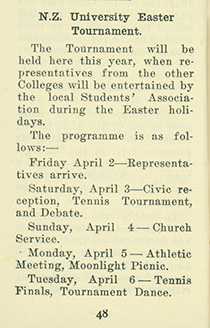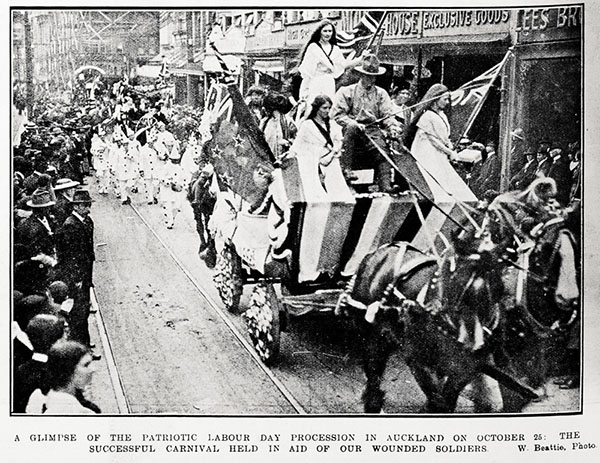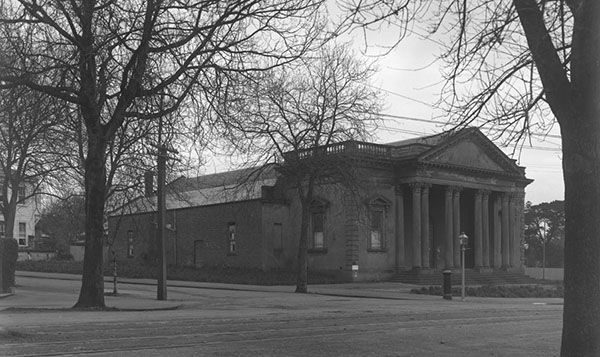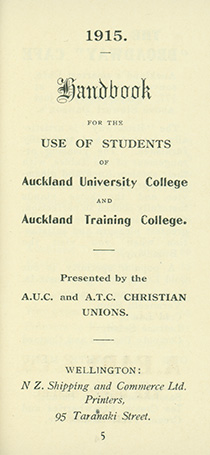
Title page of the pocket-sized 1915 student handbook.Handbook, Auckland University College Students’ Association, 1915. NZGC 378.95 A891h, Special Collections, University of Auckland Libraries and Learning Services.
The College in 1915
During 1915, New Zealand’s continued involvement in the war encroached on many aspects of campus life at Auckland University College (AUC), particularly after the Gallipoli Landings in the April.
In February, Lieutenant Eric Hardwick Tayler became the first Collegian to die on active service. By October when the 1915 issue of The Kiwi was published, there were 13 more names to record in the magazine’s first list of the war dead and a further 23 to list as wounded or missing. The issue also featured war-related advertisements, poems, a cartoon alluding to ‘Uncle Sam’s’ lack of interest in the conflict and the revealing quip that ‘Khaki is becoming the fashion at Coll. nowadays’ and ‘the best key to unlock the feminine heart.’
Even public lectures given by College staff under the auspices of the YMCA Educational Committee were war-related, including ‘The Law of war on the sea’, presented by Law professor R.M. Algie in August and ‘Aspects of the War’, by History lecturer J.P. Grossmann in September.
In 1915, the number of students attending lectures at AUC fell to 539, 126 fewer than in 1913. Numbers continued to fall as the year progressed with one staff member commenting that ‘scarcely a lecture passed without one or more resignations from students who had enlisted’. Many of the club reports in The Kiwi also mentioned members leaving to join the armed forces, although some clubs, including the Debating Club, noted that they had plenty of members in spite of the ‘general depression caused by the war’. However, it was not only students who were leaving the College for the Front; by the end of the year two staff members had enlisted, Silston Cory-Wright, lecturer of Surveying, Hydraulics and Principles of Civil Engineering and Structural Design, and Joseph Vivian Wilson, assistant lecturer in Classics.
Campus life was also changing for the trainee teachers at the nearby Auckland Training College (ATC). Many trainees also took papers at AUC and more than 150 Collegians listed in the Roll were former or current students of the Training College. By Easter 1915, a number of senior ATC students were filling school positions left vacant by teachers who had gone to war while 20 former students were listed as serving at the Front.
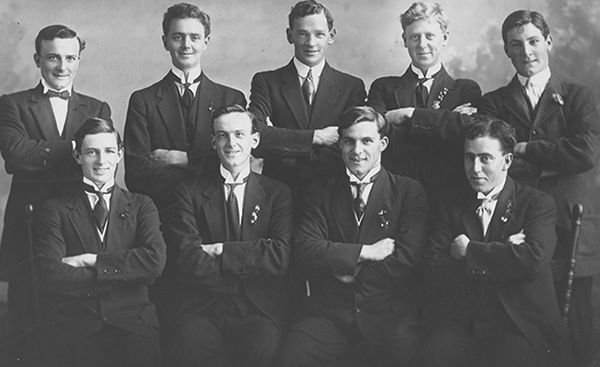 Auckland Training College Men’s Social Committee, 1915. Two men who have been tentatively identified, Thomas Cronin (centre back) and Lewis Cheeseman (front right), both served.Faculty of Education Archives.
Auckland Training College Men’s Social Committee, 1915. Two men who have been tentatively identified, Thomas Cronin (centre back) and Lewis Cheeseman (front right), both served.Faculty of Education Archives.





